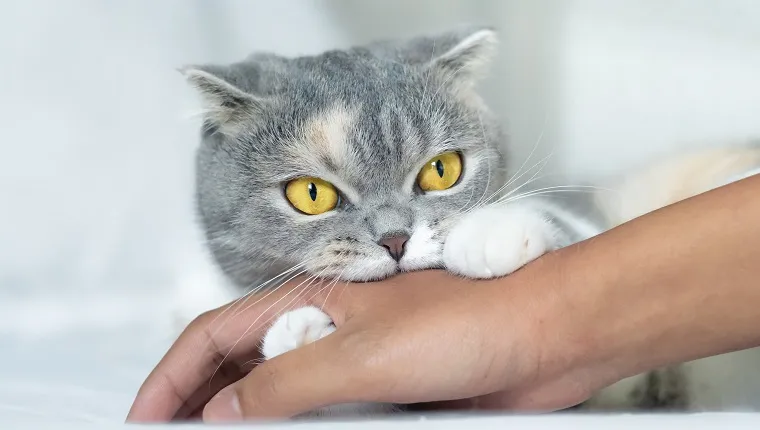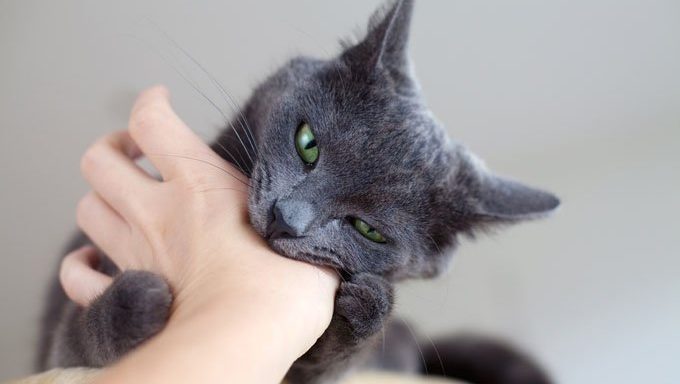Cats have teeth, and those teeth bite! Even the sweetest cat might nip or bite if the occasion arises.
The reasons for this behavior make sense to the cat, even though it may seem unprovoked to you. Why is kitty giving you the chomp when you were just trying to show affection?
Here are a few possible explanations for your cat’s biting, along with a some possible solutions for curbing the unwanted behavior.
Play Aggression
Cats stalk, leap, grab, chase, run, and ambush in the name of fun and catching mice. If your bare toes are wiggling on the carpet, your cat might mistake them for something tasty and stalk your toes until kitty pounces and bites.
This behavior may seem cute when a kitten does it, but not when your adult cat chomps down on your toe with full hunting force.
Try playing with fishing pole type toys to keep those teeth away from your skin. Don’t let your fingers dangle over a cat when you play with them, as they might mistake those digits for toys.
Teaching your cat to only go after appropriate toys, rather than body parts, will go a long way in stopping the bites.
Petting-Induced Aggression

Suddenly the happily purring cat you’ve been petting turns their head, bites your hand, and jumps to the floor.
This type of aggression is not well understood. Animal behaviorists believe too much physical contact irritates a cat if they have a low threshold for stimulation.
Usually your cat gives you a warning sign before they bite. You need to watch for these signals:
- Quickly turning their head toward your hand
- Flattening their ears or rotating them
- Twitching their tail
- Restlessness
- Dilated pupils
If you see any of those signs, stop petting the cat. If you’re holding them, put kitty on the floor. The main solution for this problem is to watch your cat’s body language and respond accordingly.
When you see signs that your cat feels overstimulated, step back and let them return to you at their own pace if they want more pets.
Territorial Aggression
Some cats protect their territory. Usually this type of aggression is shown toward other cats, but it can be directed toward people or other pets.
A cat marks their territory by patrolling an area, then chin rubbing or spraying urine to mark a particular place. The cat ambushes or chases an intruder away from their area while displaying offensive postures and behaviors such as hissing or swatting.
The cat’s territory could be the entire house, a room, or even the litter box.
This can be a difficult behavior to address. However, you can use training and conditioning to help the cat get along with whoever triggered this reaction in the first place, whether it’s a human or another pet.
Consult your vet or a professional behaviorist, as they can better understand the needs of your individual feline. Have patience for yourself and your cat during this process.
Redirected Aggression

This type of aggression occurs when a cat is aroused by another cat, a pet, or a person they can’t reach.
For example, a cat walking outside past the window may upset a cat in the home. The indoor cat can’t get out and reach the trigger of their anger. Instead, they lash out at whoever is closest, whether that’s another household animal or a person.
This type of aggression is dangerous because the cat is out of control. They’re highly overstimulated and direct aggression anywhere they can.
To keep from being bitten, do not approach an agitated cat. Walk away and let the cat calm down. You should speak to your vet or behaviorist if this happens frequently, as it can be dangerous to you, your cat, or any person or pet who approaches the cat in that state.
It’s also important to check with your vet if your cat suddenly begins biting or showing aggressive behavior when they haven’t before. If there’s no medical cause for the biting behavior, you might be referred to an animal behaviorist for help. Finding the cause of biting aggression and treating it promptly is important.
Does your cat ever bite? Why do you think they do it? How do you get them to stop? Let us know in the comments below!









